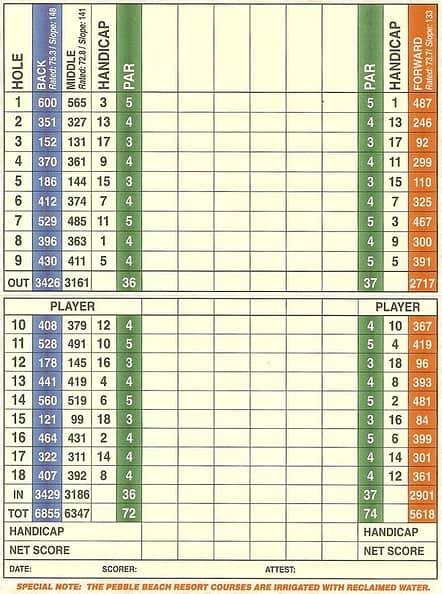Everything You Need to Know About the World Handicap System for Golf
The World Handicap System became the global golf handicap system on January 1, 2020. There used to be six different handicap systems around the world! The good news for US golfers is that the system is similar to the former USGA system. In this article, we discuss the changes from the World Handicap System and how to use it to calculate your Handicap Index correctly.
No More ESC!
First and foremost, the Equitable Stroke Control (ESC) is gone! Fuggedaboutit. It’s done. Over. Finished. ESC ended when the World Handicap System went into effect at the beginning of 2020. That said, many golfers are still confused about how to enter their scores and how the new system works. The good news is that the new rule is much easier...

The New Rule is Net Double Bogey
Net double bogey - it is so simple and straightforward. The new rule is that you cannot take more than a net double bogey on any hole. For example, if your course handicap is a 15, then on the 15 hardest holes, the most you can record is a triple-bogey. On the easiest 3, the most you can record is a double-bogey. (See text below on how course handicap and index are not the same thing!)
This is a significant improvement to the crazy ESC system. The only difficulty is that you have to pay a bit more attention to your course handicap and your scorecard to make sure you correctly enter your score. Many of the handicap apps now encourage you to enter your score hole-by-hole, thus the score is always correctly calculated. We recommend that you use one of these apps when available. This new rule can make a big difference in the calculation. For example, let's say you shoot an 8 on a par 3 and that this par 3 is the 17th handicap hole and your course handicap is a 15. This means that a 5 is the most you can record on this hole for the purposes of calculating your Handicap Index. Under the old ESC system, your score would have been a 7. It's this type of math that is causing many people's Handicap Indexes to go down!

The Best 8
For those of us in the US, the former USGA system would use the best 10 of the last 20 rounds to calculate your handicap. In the new system, it’s the best 8 of the last 20. For all but the most consistent golfers, this means that your index should have gone down a bit in the new system. Make sure you are aware of this when playing those sandbagging opponents who have been saying their index is the same number as it’s been for the last five years.
Your Index Updates Every Night
Many of the handicap systems in the US were updating twice per month. Now, it is updating every night, which makes things far more timely. The good news is that if your buddy took all your money because he shot the round of his life today, he will be giving you more strokes tomorrow!
Playing Conditions Matter
One of the best things about the new World Handicap System is that the playing conditions are now part of the scoring! There is a new factor in the equation called the PCC (Playing Conditions Calculation). It is an automatic adjustment in the range of -1 to +3 that will be applied to the Score Differentials of all players on the course that day (see below for explanation of Score Differential). It is automatically calculated if there were at least 8 scores posted by players with an index of 36 or below. So if you struggled to hit the ball into that 40 mph wind, your index will automatically take that into account.
Different tee boxes? No Problem
Course handicaps are now tied to par, not the Course Rating. This won’t mean much to most golfers (unless you were really into Course Ratings). The net effect is that this makes it far easier to set up a fair competition between golfers playing from different tees.

So How Does the World Handicap System Work?
Before we get into how to calculate your handicap, we need to understand a few basic terms. Once you know the terms, the actual calculation is relatively simple.
What is a Handicap?
First and foremost, the term ‘handicap’ is a measure of a golfer’s potential ability. People often quote their ‘index’ when people ask for their ‘handicap.’ This is not technically correct, but most golfers know when you say handicap, you mean your Handicap Index.
What’s the Difference Between a Handicap Index and a Course Handicap?
Your Handicap Index (commonly called just "index’) is a number calculated based on your performance over your last 20 rounds of golf. This historical indicator is a measure of just how good you could be relative to other golfers.
Your Course Handicap is calculated using your Handicap Index and the difficulty of a given course to indicate how well you could play on that specific course. The Course Handicap is used to balance competition between players of different ability on the same course.
How do I Calculate my Course Handicap?
Well, you first have to have a Handicap Index. The right way to get an index is to join a local golf club and use their system to track it. These systems allow for peer review, so that all of your opponents can see the scores you have entered. If you are not part of a club, there are website calculators that will help you calculate your Handicap Index. Once you have an established Handicap Index, you use the following formula to calculate a Course Handicap (and round to the nearest whole number):
Course Handicap = Index * (Slope Rating of Tees / 113) + (Course Rating – Par)
Let's walk through an example. Let's say you are going to play golf today. Let's assume your Handicap Index is 12.6 and the Slope Rating of the tees you are going to play is 138. The Course Rating is 72.1 and Par is 72). Therefore, your course handicap is:
Course Handicap = 12.6 * (138 / 113) + (72.1 – 72) = 15.49
Therefore, your Course Handicap for this course is 15.
Let's say your opponent has an index of 14.7. Therefore, his handicap for the course is:
Opponents Course Handicap = 14.7 * (138/113) + (72.1 – 72) = 18.05
Therefore, if you are playing match play, you will have to give your opponent one stroke on each of the three hardest holes (Handicaps 1-3 on the scorecard). This is one of those unfortunate situations where the difference in Handicap Indexes is only 2.1 but when converted to Course Handicaps, it is a difference of three strokes.
Calculating Your Handicap Index
Now that we understand the Course Handicap, let's discuss how to calculate a Handicap Index. As of January 1, 2020, the entire golfing world is using the World Handicap System. Under this system, your Handicap Index is equal to the average Score Differential of your 8 best rounds of golf out of the last 20 rounds of golf you have played. This means that your 12 worst scores are ignored. This is simple enough, once you know how to calculate your Score Differential.
What is a Score Differential?
Now we are getting into the meat of the calculation of a Handicap Index. Simply put, a Score Differential is how well you played on a given course. It takes many factors into consideration – the Course Rating, the Slope Rating and even the playing conditions! For those of you that like the math, your Score Differential for a given round is calculated using this formula:
(113 / Slope Rating) x (Adjusted Gross Score - Course Rating - PCC adjustment)
Let’s break this down. The 113 represents the Slope Rating for an average golf course. If the slope of the course you are playing is greater than 113, then it is a harder course and that needs to be accounted for.
What Exactly is a Slope Rating?
The Slope Rating is a measure of how difficult a course would be for a bogey golfer compared to a scratch golfer. There is an entire formula for how Slope Rating is calculated (see sidebar below) but just know that every course has a Slope Rating, it shows how difficult the course is, and it will be used to calculate your index.
The Adjusted Gross Score
This is your net double bogey score. Take our example above. Since your Course Handicap was 15 for the course, you can not record more than a triple-bogey for the handicap 1-15 holes. On the 16-18 handicap holes, the most you can record is a double bogey.
The Course Rating
The Course Rating is a representation of how hard the course would be for a scratch golfer. There are 26 evaluations for each set of tees on a course to help determine the Course Rating. This includes fairway width, bunker depth, bunker location, size of green, contour of greens, hazard distances, etc. Each course is required to be rated every 10 years but the ratings are usually more frequent.
The Playing Conditions Calculation (PCC)
This is an adjustment factor used to make adjustments for the conditions of a course on a given day. It is done automatically by the course, but for those of you that just need to know, see the explanation below.
How a Golf Course Determines the PCC
1) Look at the expected score for every player that day with an index less than 36
2) Calculate the expected standard deviation of Score Differentials on the course, using all the Slope Ratings
3) Determine how many players scored differently (better or worse) than their expected scores.
4) If a statistically significant amount of players scored better or worse than expected, a PCC value is applied. These values range from -1 to +3.
That covers the basics of calculating your Handicap Index and determining a Course Handicap so that you can compete fairly with other golfers.
Want more detail? The USGA has a great FAQ page on the implementation of the World Handicap System.
Have additional questions? Want something clarified? Ask a question in the comments!
